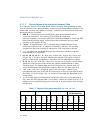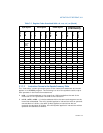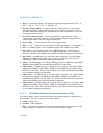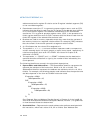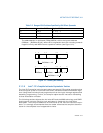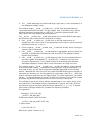
3-8 Vol. 2A
INSTRUCTION SET REFERENCE, A-M
address contained in register SI relative to the SI register’s default segment (DS)
or the overridden segment.
• Parentheses around the “E” in a general-purpose register name, such as (E)SI,
indicates that the offset is read from the SI register if the address-size attribute
is 16, from the ESI register if the address-size attribute is 32. Parentheses
around the “R” in a general-purpose register name, (R)SI, in the presence of a
64-bit register definition such as (R)SI, indicates that the offset is read from the
64-bit RSI register if the address-size attribute is 64.
• Brackets are used for memory operands where they mean that the contents of
the memory location is a segment-relative offset. For example, [SRC] indicates
that the content of the source operand is a segment-relative offset.
• A ← B indicates that the value of B is assigned to A.
• The symbols =, ≠, >, <, ≥, and ≤ are relational operators used to compare two
values: meaning equal, not equal, greater or equal, less or equal, respectively. A
relational expression such as A ← B is TRUE if the value of A is equal to B;
otherwise it is FALSE.
• The expression “<< COUNT” and “>> COUNT” indicates that the destination
operand should be shifted left or right by the number of bits indicated by the
count operand.
The following identifiers are used in the algorithmic descriptions:
• OperandSize and AddressSize — The OperandSize identifier represents the
operand-size attribute of the instruction, which is 16, 32 or 64-bits. The
AddressSize identifier represents the address-size attribute, which is 16, 32 or
64-bits. For example, the following pseudo-code indicates that the operand-size
attribute depends on the form of the MOV instruction used.
IF Instruction ← MOVW
THEN OperandSize ← 16;
ELSE
IF Instruction ← MOVD
THEN OperandSize ← 32;
ELSE
IF Instruction ← MOVQ
THEN OperandSize ← 64;
FI;
FI;
FI;
See “Operand-Size and Address-Size Attributes” in Chapter 3 of the Intel® 64
and IA-32 Architectures Software Developer’s Manual, Volume 1, for guidelines
on how these attributes are determined.
• StackAddrSize — Represents the stack address-size attribute associated with
the instruction, which has a value of 16, 32 or 64-bits. See “Address-Size





